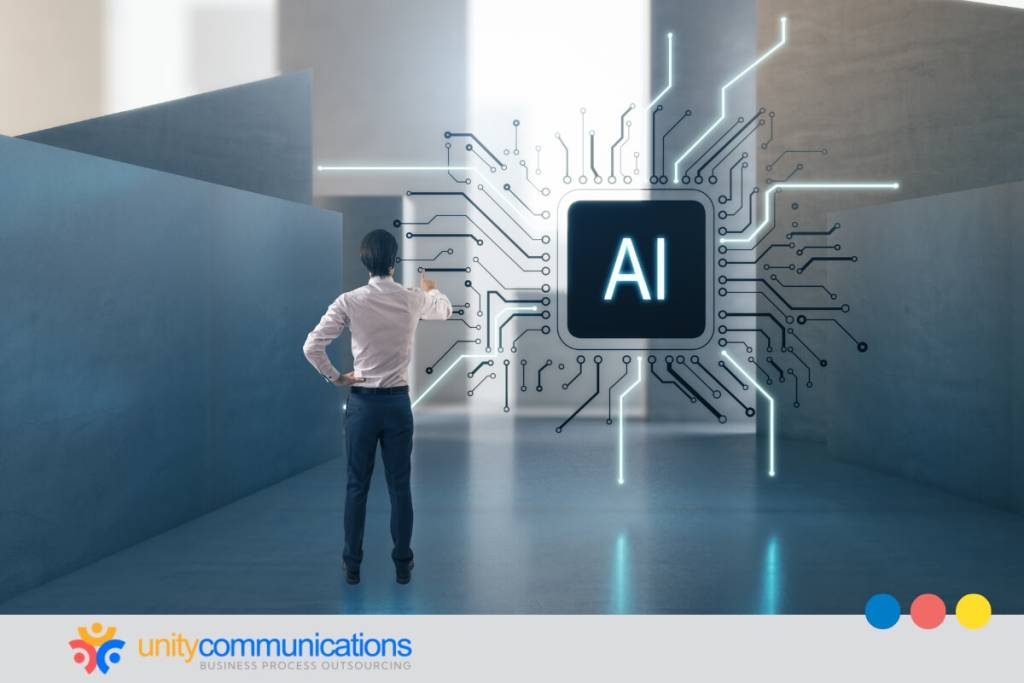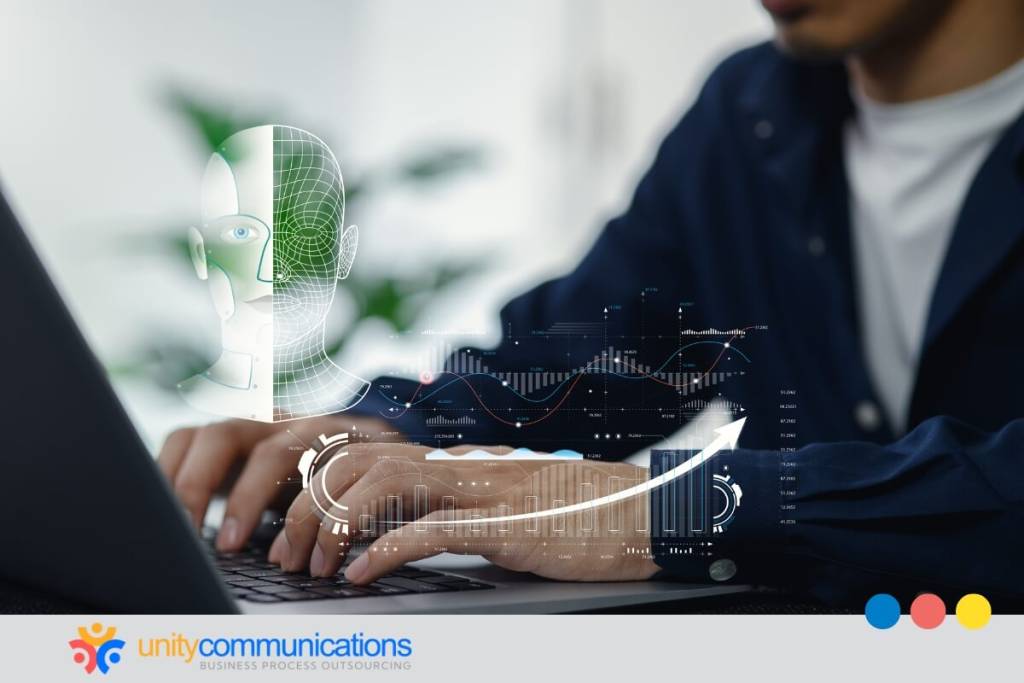Table of Contents
Customers want fast, personalized, and seamless interactions when seeking product information, troubleshooting an issue, or completing a purchase. Intelligent virtual agents (IVAs) can help meet these demands at scale.
IVAs use conversational AI, natural language processing (NLP), and contextual understanding to deliver smarter, more human-like interactions.
This article explains what IVAs are, how they operate, and the measurable value they bring to modern enterprises. It will also give you a comprehensive overview of IVAs and how they can transform your operations.
What is an intelligent virtual agent (IVA)?

An IVA is an AI-powered system that simulates human-like conversations and assists customers or employees in real time. They differ from traditional chatbots that follow static scripts. An AI virtual agent uses NLP, machine learning (ML), and contextual awareness to understand intent, respond accurately, and adapt to new interactions.
The primary purpose of an IVA is to deliver efficient, scalable, and personalized support. These agents can handle routine inquiries, resolve common issues, and even execute end-to-end workflows, freeing up human employees to focus on higher-value tasks.
They can handle complex questions, examine multiple data sources, and tailor answers to the given context. At the same time, they ensure consistent customer experiences across channels, whether that’s voice, chat, or self-service platforms.
The rise of AI agents reflects the growing demand for more intelligent automation. According to Gartner, by 2026, one in 10 agent interactions will be automated.
Core components of IVAs
Behind every AI-powered virtual agent is a sophisticated combination of technologies and capabilities that make it more advanced than traditional chatbots. These components work together to deliver human-like, context-driven, and scalable interactions.
1. NLP
NLP is the backbone of intelligent conversations. It helps virtual agents understand the words customers use, as well as the meaning, intent, and sentiment behind them. For example, if a customer says, “I’m having trouble logging into my account,” the IVA recognizes this as a login issue, even if the phrasing differs from standard questions.
NLP also enables multilingual support, allowing you to cater to global customers without requiring additional human resources. The sophistication of NLP ensures that customers don’t feel as if they’re interacting with a rigid script, but rather with a responsive, human-like assistant. This matters because consumers want natural, conversational experiences over robotic interactions.
Advancements in NLP can also help intelligent virtual assistants improve their understanding of slang, context, and industry-specific terminology. This helps reduce customer frustration and increase trust.
2. AI-driven dialog management
AI-driven dialog management keeps conversations with an intelligent virtual agent coherent, goal-oriented, and efficient. Unlike basic systems that follow linear flows, dialog management enables the system to dynamically adjust conversations based on user behavior and desired outcomes.
It prevents conversations from stalling or becoming repetitive. Instead, the conversation naturally progresses toward a resolution. For example, if a customer switches topics mid-conversation, the IVA can pivot smoothly without losing track of the original issue.
Strong dialog management also helps seamlessly escalate complex cases to human agents, transferring context so your customers don’t need to repeat themselves.
Studies show that 43% of contact centers have already adopted AI technologies, leading to a 30% reduction in operating costs. This demonstrates how advanced dialog management directly improves efficiency and cost savings.
3. ML
ML allows intelligent virtual agents to grow smarter over time. Unlike static automation systems, ML models learn from every interaction. They can identify patterns, refine responses, and predict the most relevant answers.
For instance, if a large number of users start asking about a new product or policy, the IVA can adapt to recognize these questions and provide accurate information, even if they weren’t explicitly programmed. This adaptability reduces the need for constant manual updates while aligning the virtual agent with your needs.
With ML, IVAs can personalize experiences, recommend the most suitable actions, and proactively resolve problems. This is what makes an AI-powered virtual agent an ever-evolving tech that delivers short-term productivity and consistent business value.
4. Contextual awareness and memory
Contextual awareness and memory enable an AI-powered virtual agent to provide more personalized, connected, and efficient interactions.
Legacy chatbots treat every question in isolation. Meanwhile, IVAs can recall previous conversations and apply that knowledge in real time. This means customers don’t have to repeat information when following up on an issue or switching between channels.
For example, if your customer checked the status of an order earlier, the IVA can immediately provide updates in the next interaction without having to start from scratch. Contextual memory also allows the agent to recognize patterns, such as a user’s preferences, and adjust responses accordingly.
Contextual awareness helps build smoother experiences and stronger relationships. Customers feel understood rather than having to start fresh each time. With it, intelligent virtual agents can act as trusted digital partners.
5. Integration with business systems
IVAs can complete tasks by connecting to customer relationship management (CRM) systems, knowledge bases, ticketing platforms, or even payment gateways. They can schedule appointments, process transactions, update records, or escalate cases directly to human agents when needed.
Seamless integration expedites resolutions and reduces the workload on employees, allowing them to focus on more complex or high-value responsibilities. It also helps unify customer data, giving businesses valuable insights into trends, behaviors, and service performance.
When embedded into workflows, IVAs bridge the gap between customers and back-office systems. As a result, you get more streamlined operations. In fact, companies that leverage AI in customer operations boost their efficiency by 25%.
How an IVA works

An IVA operates through a series of interconnected processes to transform user input into meaningful, goal-oriented interactions. The process typically begins with input recognition.
With NLP, the IVA interprets customer questions across text or voice channels. From there, AI-driven dialog management guides the conversation flow, ensuring it remains relevant while allowing flexibility if a user changes topics. Simultaneously, ML analyzes patterns to refine responses and anticipate needs.
Next, the IVA taps into contextual awareness and business integrations. It retrieves data, executes actions, and delivers personalized outcomes by connecting to CRM systems or ticketing tools. For example, the IVA can reset a password, provide an order update, or route a complex issue to a human agent without breaking the conversational flow.
In practice, these capabilities power diverse examples of AI agents across industries:
- Retail. Agents guide customers through personalized shopping recommendations, check product availability, and process returns.
- Banking and finance. They assist with balance inquiries, loan applications, or fraud alerts while maintaining compliance.
- Healthcare. They assist patients in scheduling appointments, explaining coverage details, and providing access to post-treatment instructions.
- Travel and hospitality. They enable real-time flight changes, hotel bookings, and itinerary updates.
- Telecommunications. They troubleshoot connectivity issues, activate services, or upgrade plans without waiting for a live agent.
These steps blend intelligence and automation to create efficient, natural, and scalable experiences.
IVAs vs. chatbots: Key differences
“Intelligent virtual agents” and “chatbots” are often used interchangeably. However, they differ in technological sophistication, context awareness, and business integration.
Complexity of interaction
Chatbots typically follow rule-based scripts or decision trees. They can handle straightforward, repetitive questions, such as “What’s my account balance?” However, they often falter when the conversation deviates from expected patterns.
IVAs employ advanced components to navigate complex, multi-turn conversations. They adapt to user intent, handle ambiguous phrasing, and shift smoothly between topics with greater fluidity.
Ability to personalize
Chatbots provide templated responses based on predefined rules. Their personalization is limited and superficial.
IVAs draw on historical interactions, integrate with CRMs, and leverage real-time context. They deliver responses tailored to individual customers, recognizing their history, preferences, and nuanced needs.
Integration and task automation
Chatbots often function in silos, detached from backend systems. They’re great for question and answers, but not ideal for executing business tasks.
IVAs seamlessly integrate with business systems to autonomously complete tasks such as scheduling, order processing, and case escalation.
Business impact
Chatbots excel at handling high volumes of simple interactions. They can manage around 75% to 90% of basic customer questions.
While capable of managing complex interactions, IVAs drive greater operational efficiency and enhanced customer experiences due to their adaptability, context awareness, and deeper integration into business processes.
While chatbots are valuable tools for handling routine inquiries, intelligent virtual agents give more thoughtful, personalized, and business-integrated experiences.
How to implement IVAs

To deploy an intelligent virtual agent, your strategy must align automation with customer expectations and business goals.
Approaching implementation thoughtfully increases the likelihood of realizing efficiency gains, higher satisfaction, and more substantial returns.
Here’s how you can do it:
1. Define objectives and use cases
The first step is to clarify why you need an intelligent virtual agent and where it will deliver the most value. Many businesses start by automating repetitive, high-volume inquiries such as password resets, order tracking, or billing questions.
Others focus on tasks that require round-the-clock support. You can also deploy IVAs internally to assist HR teams with employee questions or help IT teams resolve tickets. By mapping out customer-facing and internal use cases, you can prioritize where the impact will be most immediate while laying the groundwork for broader adoption.
2. Select the right technology partner
Not all IVA solutions are created equal. Look for platforms that offer robust NLP, AI-driven dialog management, and seamless integration with your existing systems.
Consider whether you need multilingual capabilities, voice and text support, or advanced analytics for continuous improvement.
A good technology partner should also provide scalability, allowing the system to grow alongside your business.
3. Integrate and align workflows
An IVA achieves its true potential when it’s not siloed. For instance, instead of telling customers how to reset passwords, the IVA can guide them through the process step by step or complete it on their behalf.
Integration also allows for better collaboration with live agents. If an issue requires escalation, the IVA can transfer all relevant context, saving customers from having to repeat themselves.
To maximize efficiency, align IVA processes with your existing workflows and train your teams on how to leverage automation as part of their daily operations.
4. Train, test, and optimize
Much like onboarding a new employee, an IVA requires initial training and ongoing development. This involves feeding it with relevant knowledge, industry terminology, and customer scenarios.
Test early pilots in controlled environments to uncover weaknesses before a full rollout. Once live, continuous monitoring of interactions provides insights into where the IVA excels and where it needs improvement.
Gathering user feedback also helps fine-tune the experience and ensure the IVA feels natural. Over time, ML allows it to become smarter, faster, and more effective.
Companies that invest in optimization see steady performance gains rather than one-time improvements.
5. Leverage BPO partnerships for faster deployment
For many businesses, the challenge is the resources required to build and maintain an IVA in-house. This is where business process outsourcing (BPO) plays a critical role.
Leading BPO providers now utilize intelligent virtual agents alongside human employees, often referred to as a hybrid outsourcing model.
Understanding how outsourcing works helps illustrate the value. Instead of purchasing the technology, training the system, and staffing a support team internally, you can partner with a BPO provider that already has these capabilities in place.
They offer a ready-made infrastructure where IVAs handle routine tasks while skilled agents manage complex issues, balancing cost efficiency and high-quality service. This accelerates deployment and reduces risk, as you benefit from the provider’s expertise and proven frameworks.
6. Measure and scale
Ultimately, successful IVA programs strongly emphasize metrics. Key performance indicators (KPIs), such as resolution rate, average handling time, cost savings, and customer satisfaction, should be tracked from the outset.
It’s also important to measure how well IVAs and human agents work together, as the most effective models are hybrid. As performance improves, you can scale IVAs to handle more channels, support additional departments, or take on new use cases.
When you embrace this iterative approach, you gain a long-term competitive edge.
The bottom line
Every business has unique needs, challenges, and customer expectations. You can tailor IVAs to meet them.
Whether automating routine inquiries, enhancing agent efficiency, or delivering seamless customer experiences, IVAs can be tailored to align with your specific goals. The result is clear: higher productivity, lower costs, and improved customer satisfaction.
To fully unlock these benefits, many companies are partnering with BPO providers that specialize in IVA integration. Having a reliable BPO partner gives you access to cutting-edge AI technology and experienced human talent in a hybrid model that delivers consistent results.
Ready to transform your customer operations? Let’s connect to implement IVAs and take your business to the next level.




